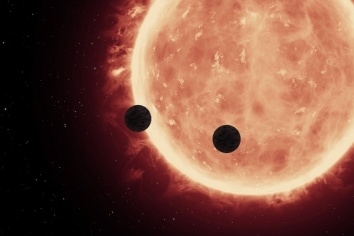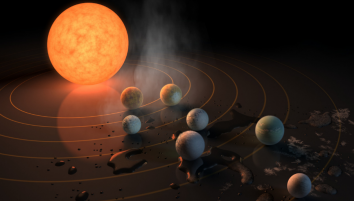
An artist’s depiction of planets passing in front of the red dwarf star in the TRAPPIST-1 system. Credit: NASA/ESA/STScl
19 June 2023
Using the James Webb Space Telescope (JWST), a Max Planck Institute for Astronomy (MPIA)-led group of astronomers searched for an atmosphere on rocky exoplanet TRAPPIST-1 c. Though the planet is nearly identical in size and temperature to Venus, its atmosphere has turned out to be very different. By analysing the heat emitted from the planet, they conclude it may only have a tenuous atmosphere with minimal carbon dioxide. However, this measurement is also consistent with a barren rocky planet without any significant atmosphere. This work contributes to our understanding of how the atmospheres of rocky planets orbiting low-mass stars can withstand their strong stellar winds and intense UV radiation.
“The nearby TRAPPIST-1 planetary system is currently the best candidate to study the atmospheres of rocky, Earth-like planets orbiting a red dwarf star,” says Sebastian Zieba, a student at MPIA in Heidelberg, Germany. He is the primary author of new research on TRAPPIST-1 c, published June 19 in the journal Nature.
Located at a distance of about 40 light-years away, TRAPPIST-1 hosts seven Earth-sized rocky planets, with up to three of them in the habitable zone. This means the radiation from the central star would produce enough heat to allow for water in a liquid form. As TRAPPIST-1 c is not located in this habitable zone, astronomers suspected it to be a Venus analogue.
Low-Mass Stars Can Erode Planetary Atmospheres
Although relatively cool on the outside, many such stars exhibit strong stellar winds and intense UV radiation over an extended period of their lifetime, potentially damaging and eroding their planets’ atmospheres. “We wanted to find out if TRAPPIST-1 c may have escaped that fate and could have retained a substantial atmosphere, and perhaps even be similar to the planet Venus in the Solar System,” Zieba explains.
The planet’s gravitational pull at the surface, which is 10% higher than that of Earth, should help retain its atmosphere. Like Venus, TRAPPIST-1 c’s diameter and mass values are a close match with those of Earth. Furthermore, the radiation it experiences from its central star is nearly identical to that of Venus.
“On Venus, we think it was hot enough to evaporate its oceans into steam, and then lose all the water to space,” says Caroline Morley, assistant professor at The University of Texas at Austin. She is a contributing author and led the modeling for this study. “Carbon dioxide is much harder to lose, so now the atmosphere of Venus is dominated by carbon dioxide.”
The task of characterizing the atmospheres of rocky, Earth-sized planets is a challenging endeavour, even for the JWST. Therefore, the team combined their observations with model calculations to find the most likely range of atmospheric properties matching the data.
The extent, pressure and composition of an atmosphere decides the temperature of a planet depending on the light it receives from its star. Conversely, the temperature determines how much infrared light the planet emits. This way, infrared measurements combined with models provide clues about the atmosphere and its composition.
“I generated models of TRAPPIST-1 c’s atmosphere, creating simulated planets with different thicknesses of atmosphere,” says Morley. “From a Venus-like atmosphere with a crushing 100-bar surface pressure to a thin Mars-like atmosphere with a tenuous atmosphere. Comparing our observations to the models lets us infer what the atmosphere is like on the planet.”
TRAPPIST-1 c Is Not Like Venus
“We can definitely rule out a thick and Venus-like atmosphere,” says Laura Kreidberg, the lead scientist of the JWST observing program and a co-author and director at MPIA. She heads the Atmospheric Physics of Exoplanets (APEx) Department. Defying the astronomers’ expectations, the temperatures “only” reach as high as 110 degrees Celsius (230 Fahrenheit, 380 Kelvin), up to 390 degrees lower than on Venus. The infrared light emitted by TRAPPIST-1 c does not match a Venusian atmosphere, rich in carbon dioxide causing a strong greenhouse effect.
In fact, the data is inconsistent with any kind of thick atmosphere rich in carbon dioxide, with surface pressures higher than ten times that of Earth. While results published on TRAPPIST-1 b earlier this year showed it to be lacking any atmosphere, similar to Mercury, TRAPPIST-1 c suggests that this planetary system is not a Solar System analogue.
TRAPPIST-1 c May Have a Thin Atmosphere
Does TRAPPIST-1 c at least have a thin gas envelope? To explore that possibility, the scientists calculated the statistical likelihood of a set of atmospheric parameters to match the observations. The atmospheric model involved a range of surface pressures and mixtures of an oxygen (O2) dominated atmosphere with varying traces of carbon dioxide (CO2).
“We expect a high abundance of oxygen with some carbon dioxide for hot rocky planets orbiting low-mass stars,” explains Zieba. Planets like TRAPPIST-1 c should possess an atmosphere containing carbon dioxide and water vapour early on in their evolution. Over time, the stellar radiation breaks up the water molecules into hydrogen and oxygen. While the highly volatile hydrogen gradually escapes into open space, the heavier oxygen molecules remain, leading to an oxygen-rich atmosphere with traces of carbon dioxide.
As it turns out for TRAPPIST-1 c, the model reflecting that assumption is consistent with a wide range of oxygen-carbon dioxide mixtures and surface pressures between 1% and 100% of Earth’s sea level values. This result raises the hope for TRAPPIST-1 c and other sufficiently heavy rocky planets around cool low-mass stars to sustain an atmosphere over a significant fraction of the stellar lifetime, as the star TRAPPIST-1 is at least as old as the Sun.
Nevertheless, those results need verification with additional data. “Observations of thin, rocky-planet atmospheres push JWST to its limits,” Kreidberg admits. The measured signals are faint, and many properties are still unknown, leading to uncertainties. In the case of TRAPPIST-1 c, atmospheric models are not the only ones that match the data. A barren rock with a surface layer of material weathered from stellar irradiation explains the observations equally well.
Observations Are Challenging, Even for JWST
While JWST is undoubtedly the most powerful space observatory ever launched, it is still very difficult to catch the heat signature of a small, moderately warm and rocky planet along with imprints of a surrounding atmosphere.
TRAPPIST-1 c is tidally-locked, always facing its central star with the same side. This leads to two distinct hemispheres - one in constant day, and another in eternal night. The planet’s rotation is locked to its trajectory around the star, and as a result, both a day and a year last approximately 2.42 Earth-days on TRAPPIST-1 c. In addition, its orbit is oriented in such a way that from our perspective it repeatedly passes in front of its star.
At the halfway point of TRAPPIST-1 c’s revolution, the star TRAPPIST-1 covers the planet, completely hiding it from our telescopes for about half an hour. However, just before and after the planet vanishes, it presents its hot and fully-lit dayside for astronomers to observe. This is the signal the team was searching for, though any hint of a thin atmosphere would be diminutive at best.
Next Steps
“I'm excited about what comes next!” says Morley. “Now we go back and observe the planet in different ways to learn more about its atmosphere – if there is one.”
Additional JWST observations are needed to distinguish between a barren rocky planet and one with a tenuous atmosphere. By measuring the light emitted by TRAPPIST-1 c over a broad wavelength range, the astronomers can catch the small absorption signatures of gases in the atmosphere.
Another option is to employ the Giant Magellan Telescope (GMT), currently under construction in the Chilean Atacama Desert. When complete, it will be the world’s largest telescope, with mirrors that span 25 meters and a resolution ten times greater than the Hubble Space Telescope.
If an atmosphere was present on one of these closely-orbiting exoplanets, it would be an encouraging sign, signalling that these tenuous gases can endure the harsh light of red dwarf stars after all.
Acknowledgements
The MPIA researchers involved in the study are Sebastian Zieba (also Leiden Observatory, The Netherlands), Laura Kreidberg and Lorena Acuña (also Aix-Marseille University, France). Caroline Morley at The University of Texas at Austin (USA) led modeling for the study.
The astronomers observed TRAPPIST-1 c as part of the JWST General Observer (GO) Program 2304, “Hot Take on a Cool World: Does TRAPPIST-1c Have an Atmosphere?” (PI: Laura Kreidberg).
The James Webb Space Telescope (JWST) is the world’s leading observatory for space exploration. JWST is an international programme led by NASA with its partners, ESA (European Space Agency) and CSA (Canadian Space Agency).
JWST’s Mid-InfraRed Instrument (MIRI), built by a European consortium of research institutions, is a multi-purpose scientific instrument for infrared wavelengths between five and 28 microns. It combines an imaging camera with a spectrograph. With the support of industrial partners, MPIA provided the mechanisms of all wavelength range steering elements, such as filter and grating wheels, and led MIRI’s electrical design.
The following research institutes are involved in this study:
Max-Planck-Institut für Astronomie, Heidelberg, Germany; Leiden Observatory, Leiden University, The Netherlands; Université Paris-Saclay, Université Paris-Cité, CEA, CNRS, AIM, France; University of Liège, Belgium; The University of Texas at Austin, USA; Stanford University, USA; Boston University, USA; Peking University, Beijing, People’s Republic of China; Aix-Marseille Université, CNRS, CNES, Institut Origines, LAM, Marseille, France; University of Washington, USA; NASA Nexus for Exoplanet System Science, University of Washington, Seattle, USA; Arizona State University, Tempe, USA; Jet Propulsion Laboratory, California Institute of Technology, Pasadena, USA; Division of Geological and Planetary Sciences, California Institute of Technology, Pasadena, USA; Laboratoire d’astrophysique de Bordeaux, Université Bordeaux, CNRS, Pessac, France; Observatoire astronomique de l’Université de Genève, Versoix, Switzerland; Centre Vie dans l’Univers, Université de Genève, Geneva, Switzerland; NASA Goddard Space Flight Center, Greenbelt, USA

An artist’s depiction of planets passing in front of the red dwarf star in the TRAPPIST-1 system. Credit: NASA/ESA/STScl

This artist’s concept depicts the TRAPPIST-1 planetary system with an ultra-cool red dwarf star at its centre. Orbiting it are seven Earth-size planets. Any of these planets could potentially have liquid water on them. Planets farther from the star are more likely to have significant amounts of ice, especially on the side that faces away from the star. Sizes and distances are not to scale. Credit: NASA/JPL-Caltech/R. Hurt (IPAC)